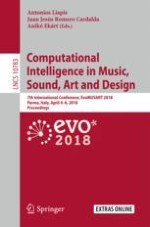2018 | Buch
Computational Intelligence in Music, Sound, Art and Design
7th International Conference, EvoMUSART 2018, Parma, Italy, April 4-6, 2018, Proceedings
herausgegeben von: Antonios Liapis, Juan Jesús Romero Cardalda, Anikó Ekárt
Verlag: Springer International Publishing
Buchreihe : Lecture Notes in Computer Science
